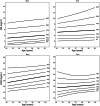Comparison of body mass index and fat mass index to classify body composition in adolescents-The EVA4YOU study
- PMID: 38386029
- PMCID: PMC11035421
- DOI: 10.1007/s00431-024-05474-x
Comparison of body mass index and fat mass index to classify body composition in adolescents-The EVA4YOU study
Abstract
The objectives of this study were to develop age- and sex-specific reference percentiles for fat mass index (FMI) and fat-free mass index (FFMI) in adolescents aged 14 to 19 years and to determine differences in overweight/obesity classification by FMI and body mass index (BMI). The EVA4YOU study is a single-center cross-sectional study conducted in western Austria. Cardiovascular risks including anthropometric measurements and bioelectrical impedance analysis were assessed in adolescents (mean age 17 years). FMI and FFMI were calculated as the ratio of fat mass (FM) and fat-free mass (FFM) to the square of height and compared to study population-specific BMI percentiles. One thousand four hundred twenty-two adolescents were included in the analysis. Girls had a significantly higher mean FM and FMI and a significantly lower mean FFM, FFMI (p < 0.001, each), and mean BMI (p = 0.020) than boys. Body composition classification by FMI and BMI percentiles shows a concordance for the < 75th and > 97th percentile, but a significant difference in percentile rank classifications between these two cut-off values (all p < 0.05). Based on FMI, 15.5% (221/1422) of the whole population and 29.4% (92/313) of those between the 75th and 97th percentiles are classified one category higher or lower than those assigned by BMI.
Conclusion: Classification of normal or pathologic body composition based on BMI and FMI shows good accordance in the clearly normal or pathologic range. In an intermediate range, FMI reclassifies categories based on BMI in more than a quarter of adolescents. Cut-off values to differentiate normal from pathologic FMI values on a biological basis are needed.
Trial registration: The study is registered at www.
Clinicaltrials: gov (Identifier: NCT04598685; Date of registration: October 22, 2020).
What is known: • Chronic non-communicable diseases (NCDs) are the leading cause of morbidity and mortality globally, with major risk factors including unhealthy diets, harmful behaviors, and obesity. Obesity in children and adolescents is a key risk factor for later NCDs, which is commonly measured by Body Mass Index (BMI). • BMI can be misleading as it doesn't distinguish between fat mass (FM) and fat-free mass (FFM), leading to potential misclassification of obesity in children. Previous studies have already suggested the use of the Fat Mass Index (FMI) and Fat-Free Mass Index (FFMI) as a more accurate measures of body composition.
What is new: • This study adds the first age- and sex-specific reference values for FMI and FFMI in Austrian adolescents using bioelectrical impedance analysis (BIA) as a safe and secure measurement method of a large representative cohort. • We found percentile misclassification between BMI and FMI when categorizing for obesity, especially in intermediate categories of body composition. Furthermore, when comparing the new reference values for FMI and FFMI to existing ones from the US, UK, and Germany we could show a good alignment within the European cohorts and major differences with American values, indicating and confirming the difference of FMI and FFMI for different populations of different ethnical background, living on different continents.
Keywords: Adolescents; Bioelectrical impedance analysis; Body mass index; Fat mass index; Fat-free mass index; Overweight.
© 2024. The Author(s).
Conflict of interest statement
The authors declare no competing interests.
Figures



Similar articles
-
Reference data for body composition parameters in normal-weight Polish adolescents: results from the population-based ADOPOLNOR study.Eur J Pediatr. 2024 Nov;183(11):5021-5031. doi: 10.1007/s00431-024-05736-8. Epub 2024 Sep 26. Eur J Pediatr. 2024. PMID: 39325216 Free PMC article.
-
Characteristics and reference values of fat mass index and fat free mass index by bioelectrical impedance analysis in an adult population.Clin Nutr. 2019 Oct;38(5):2325-2332. doi: 10.1016/j.clnu.2018.10.010. Epub 2018 Oct 18. Clin Nutr. 2019. PMID: 30389251
-
Reference norms for a fat-free mass index and fat mass index in the Japanese child population.J Physiol Anthropol Appl Human Sci. 2003 Nov;22(6):293-8. doi: 10.2114/jpa.22.293. J Physiol Anthropol Appl Human Sci. 2003. PMID: 14646264
-
Measurement and definitions of obesity in childhood and adolescence: a field guide for the uninitiated.Nutr J. 2007 Oct 26;6:32. doi: 10.1186/1475-2891-6-32. Nutr J. 2007. PMID: 17963490 Free PMC article. Review.
-
Higher Body Fat in Children and Adolescents With Type 1 Diabetes-A Systematic Review and Meta-Analysis.Front Pediatr. 2022 Jun 24;10:911061. doi: 10.3389/fped.2022.911061. eCollection 2022. Front Pediatr. 2022. PMID: 35813369 Free PMC article.
Cited by
-
Reference data for body composition parameters in normal-weight Polish adolescents: results from the population-based ADOPOLNOR study.Eur J Pediatr. 2024 Nov;183(11):5021-5031. doi: 10.1007/s00431-024-05736-8. Epub 2024 Sep 26. Eur J Pediatr. 2024. PMID: 39325216 Free PMC article.
-
Longitudinal Relationships of Physical Activity, Sedentary Time, Cardiorespiratory Fitness, and Muscular Fitness with Body Fatness in Preschoolers.Sports (Basel). 2024 Aug 30;12(9):237. doi: 10.3390/sports12090237. Sports (Basel). 2024. PMID: 39330714 Free PMC article.
-
Risk factors for pressure injuries in individuals with spinal cord injuries who have sarcopenic obesity: A comparison of time-dependent changes in sacral region pressure between individuals with and without sarcopenic obesity.J Spinal Cord Med. 2025 May;48(3):438-446. doi: 10.1080/10790268.2024.2379068. Epub 2024 Jul 24. J Spinal Cord Med. 2025. PMID: 39047200 Free PMC article.
-
Impact of Excess Adiposity on Cardiorespiratory Fitness in Children and Adolescents with Kawasaki Disease.Life (Basel). 2025 Feb 10;15(2):264. doi: 10.3390/life15020264. Life (Basel). 2025. PMID: 40003673 Free PMC article.
References
-
- Lozano R, Naghavi M, Foreman K, Lim S, Shibuya K, Aboyans V, Abraham J, et al. Global and regional mortality from 235 causes of death for 20 age groups in 1990 and 2010: a systematic analysis for the Global Burden of Disease Study 2010. Lancet. 2012;380:2095–2128. doi: 10.1016/S0140-6736(12)61728-0. - DOI - PMC - PubMed
-
- World Health Organisation . Global status report on noncommunicable diseases 2014. 1. Geneva: WHO Press; 2014.
Publication types
MeSH terms
Associated data
Grants and funding
LinkOut - more resources
Full Text Sources
Medical

